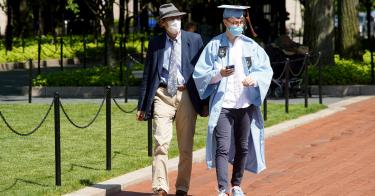College administrators have two things on their minds right now: how to reopen their campuses safely, and what steps they need to take to survive financially.
The answer to the first question depends in part on the second.
The business shutdowns precipitated by the coronavirus have eroded—and will continue to erode—nearly every source of university revenue: endowment funds, tuition, charitable contributions, and state appropriations. But the pandemic has simply exacerbated—rather than created—this fiscal peril.
>>> What’s the best way for America to reopen and return to business? The National Coronavirus Recovery Commission, a project of The Heritage Foundation, assembled America’s top thinkers to figure that out. So far, it has made more than 260 recommendations. Learn more here.
Colleges have needed a fiscal course correction for decades. Having failed to rectify years of mismanagement, they should not expect Washington to bail them out now.
Consider, for example the growth in non-teaching staffing over the decades. As the National Association of Scholars points out, non-instructional staff and administrative positions now account for more than half of university payroll costs.
University of Arkansas Professor Jay Greene has tracked this bloat for two decades now, reporting on higher education’s “diseconomies of scale.” Greene and his research team found that from 1993 to 2007, real per-student spending on administration increased 61 percent, driven by a nearly 40 percent increase in the number of administrators per 100 students. Between 2001 and 2011, the number of college administrators and non-teaching employees increased 50 percent faster than the number of teaching faculty. Look at the charts in HowCollegesSpendMoney.com … and weep.
That administrative bloat, coupled with virtually open-ended access to federal subsidies, has created much of the financial hazard with which universities must now wrestle. The coronavirus didn’t create this challenge, but it has exposed it starkly.
What’s needed is leadership. College regents and boards of trustees should work closely with administrators to right the budgetary ship. And they should be diligent, probing, and bold in their approach.
For starters, they must analyze information about revenue and spending at a more granular level than in the past. You can’t manage what you don’t measure, and to measure you need good data.
As fiduciaries, regents and trustees have a right to get this information; it’s critical to making good decisions, and their universities’ future depends on it. Intense ideological differences on where to cut are to be expected, so leaders must be thoughtful and prepared to hash things out rationally.
To address administrative bloat, a good first step is to ask for a formal review of administrative and non-teaching positions. At public universities those findings should be public: states should evaluate reductions in administrative overhead when they consider their support.
Schools should not balance the books on the backs of their student. They should direct resources where they will make the most impact: to teaching and learning.
To evaluate productivity, colleges should assess and prioritize academic programs according to how critical they are to the school’s fundamental mission and to the future of our workforce. A recent study commissioned by the Association of American Colleges and Universities found that fewer than three in 10 employers think that recent college graduates are well prepared for work, particularly when it comes to written and oral communication skills and critical thinking.
To bridge this gap, academic offerings and teaching strategies need to respond to critical input from employers, who can help schools stay abreast of the rapidly changing job market. It’s in the best interest of both universities and employers to collaborate and help prepare students for life beyond college. Program prioritization can help achieve this and allocate precious resources effectively.
Third, to improve engagement and reduce costs, leadership should rethink how their universities deliver instruction, and how students learn. Our future will be built around intelligence. Four decades ago, virtually no one owned a computer. Two and a half decades ago, smartphones didn’t exist. Colleges can leverage technology to enhance faculty and student engagement, provide access to more students, and reduce the cost of delivering quality education. They should incentivize staff and faculty to embrace this change.
These are immediate first steps. If trustees and regents help lead on this important review, state and local policymakers will follow their lead in long-overdue reform.
Reform, not federal bailouts, is what colleges and universities truly need. Higher education already received nearly $14 billion in new funding through the Higher Education Emergency Relief Fund passed as part of the CARES Act.
Nearly all sectors of society are hurting financially right now, not just colleges. Additional bailouts would add to the deficit, burdening future generations of Americans while insulating universities from making necessary changes.
Congress should instead provide breathing room to universities to innovate and pursue necessary changes. Reforming accreditation to provide regulatory relief would be a most positive step in that direction. No longer should accreditors obstruct the inter-institutional partnerships that increase efficiency and lower costs. Congress should move accreditation to its original function—as a mechanism for quality assurance and improvement—removing the monopoly currently granted to regional accreditors.
Guarding the status quo may seem comforting to tenured faculty, highly paid administrators, and, sadly, some politicians. America’s higher education was once the indisputable envy of the world. With a willingness to look inward and pursue a course correction, we can emerge from this crisis and regain the excellence we have lost through wasteful mismanagement.
This piece originally appeared in The Daily Signal



